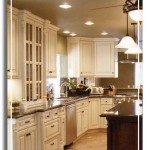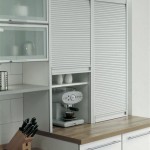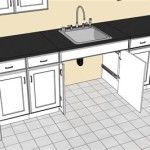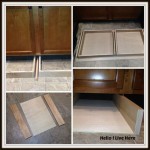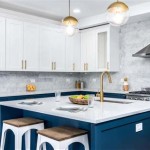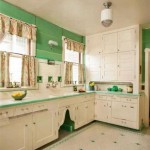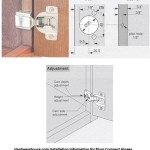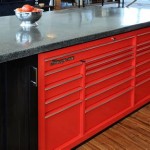Best MDF Kitchen Cabinets: A Comprehensive Guide
Medium-density fiberboard (MDF) has become a prevalent material in modern kitchen cabinetry due to its affordability, versatility, and consistent surface. When choosing kitchen cabinets, understanding the qualities, advantages, and potential drawbacks of MDF is crucial for making an informed decision. This article explores the characteristics of MDF cabinets, analyzes their strengths and weaknesses, and provides guidance on selecting the best MDF options for a kitchen renovation or new build. This information will empower homeowners and contractors alike to evaluate MDF cabinets alongside other materials and determine if they align with specific project requirements and aesthetic preferences.
Understanding MDF Composition and Manufacturing
MDF is an engineered wood product created by breaking down hardwood or softwood residuals into wood fibers, often using a defibrator, combining it with wax and a resin binder, and forming panels by applying high temperature and pressure. This process distinguishes it from plywood, which consists of layers of wood veneer glued together. The resulting MDF panels have a uniform density and a smooth surface, making them ideal for painting and finishing.
The consistency of MDF derives from the fine wood fibers used in its construction. These fibers are significantly smaller than the wood chips used in particleboard, contributing to a denser and more stable product. The resin binder, typically a urea-formaldehyde resin, binds the fibers together and provides strength and durability. While concerns regarding formaldehyde emissions have been raised, modern MDF manufacturing often utilizes low-formaldehyde or no-added-formaldehyde (NAF) resins, mitigating these concerns.
The manufacturing process allows for precise control over the dimensions and thickness of MDF panels. This precision contributes to the ease of fabrication and installation of MDF cabinets. The uniform surface also eliminates the need for extensive sanding or preparation before painting, further streamlining the manufacturing process.
Advantages of Choosing MDF Kitchen Cabinets
MDF cabinets offer several distinct advantages that make them a compelling choice for kitchen design. These advantages relate to cost, aesthetics, stability, and workability, addressing various needs and preferences in kitchen renovations.
Cost-Effectiveness: MDF is generally more affordable than solid wood. This cost advantage allows homeowners to allocate budget to other elements of their kitchen design, such as countertops, appliances, or hardware. The lower material cost also makes MDF cabinets a suitable option for large-scale projects or rental properties where budget constraints are a significant factor.
Smooth and Consistent Surface: The smooth, knot-free surface of MDF provides an ideal canvas for painting and finishing. This surface ensures a uniform color application and a flawless appearance. Unlike solid wood, MDF does not have a grain pattern that can affect the paint's appearance. The smooth surface also makes MDF suitable for intricate detailing and decorative moldings.
Resistance to Warping and Cracking: MDF is less susceptible to warping and cracking than solid wood, especially in environments with fluctuating humidity levels. Solid wood expands and contracts with changes in humidity, which can lead to warping, cracking, and joint separation. MDF, due to its stable composition, is less affected by these fluctuations, maintaining its shape and structural integrity over time. This stability makes MDF cabinets a suitable choice for kitchens in humid climates or areas with significant temperature variations.
Workability and Design Versatility: MDF is easy to cut, shape, and machine, allowing for intricate designs and detailed profiles. This workability makes it a versatile material for creating custom cabinet styles and features. The ability to shape MDF easily allows for the creation of raised panel doors, decorative moldings, and other architectural details that would be more difficult and expensive to achieve with solid wood.
Sustainability Considerations: MDF can be manufactured using recycled wood fibers, contributing to sustainable building practices. By utilizing waste materials from other wood processing operations, MDF production reduces the demand for virgin timber. Choosing MDF cabinets made from recycled content supports environmentally responsible construction and reduces the carbon footprint of the kitchen renovation project.
Disadvantages and Considerations for MDF Cabinets
While MDF offers numerous benefits, it also has some limitations that should be considered before making a purchase. These limitations primarily relate to moisture resistance, weight, and repairability.
Moisture Sensitivity: MDF is susceptible to water damage. If exposed to moisture, MDF can swell, warp, and lose its structural integrity. This sensitivity is a significant concern in kitchens, where spills and leaks are common. To mitigate this risk, MDF cabinets should be properly sealed and protected from moisture. Avoid using MDF in areas that are directly exposed to water, such as under the sink or near the dishwasher. Ensure proper ventilation in the kitchen helps to reduce humidity and prevent moisture buildup.
Weight: MDF is heavier than some other cabinet materials, such as particleboard or plywood. This weight can make installation more challenging and may require additional structural support, especially for upper cabinets. The increased weight also adds to the transportation costs of MDF cabinets. Consider the weight of the cabinets when planning the installation and ensure that the supporting structure is adequate to handle the load.
Repairability: MDF is difficult to repair if damaged. Unlike solid wood, which can be sanded and refinished, MDF is more challenging to restore if it is chipped, dented, or scratched. Repairs to MDF typically involve filling the damaged area with wood filler, sanding it smooth, and painting or refinishing it. However, the repair may not be seamless, and the repaired area may be noticeable. In some cases, it may be more cost-effective to replace the damaged panel or cabinet entirely.
Formaldehyde Emissions: Traditional MDF manufacturing processes used urea-formaldehyde resins, which can emit formaldehyde gas. Formaldehyde is a known irritant and potential carcinogen. However, modern MDF production often utilizes low-formaldehyde or no-added-formaldehyde (NAF) resins, significantly reducing formaldehyde emissions. When selecting MDF cabinets, look for products that are certified to meet low-emission standards, such as the California Air Resources Board (CARB) Phase 2 standards or the U.S. Environmental Protection Agency (EPA) TSCA Title VI standards. These certifications ensure that the MDF cabinets meet stringent requirements for formaldehyde emissions and are safe for indoor use.
Screw Holding Strength: While MDF is dense, it doesn't hold screws as well as solid wood. Over time, screws can loosen, especially if subjected to repeated stress or vibration. To improve screw holding strength, use longer screws and consider using wood glue in conjunction with screws. Avoid over-tightening screws, as this can strip the MDF and further weaken the connection. Consider using specialized hardware designed for use with MDF, such as screws with deeper threads or inserts that provide a stronger anchor point.
Selecting the Best MDF Kitchen Cabinets
Choosing the best MDF kitchen cabinets involves considering several factors, including the quality of the MDF, the finish, the construction methods, and the hardware. By carefully evaluating these aspects, homeowners can select MDF cabinets that meet their needs and preferences.
MDF Quality: The quality of the MDF used in the cabinets is crucial for their durability and performance. Look for MDF that is dense and free from voids or imperfections. The surface should be smooth and uniform, without any bumps or ridges. High-quality MDF will be less prone to swelling and warping when exposed to moisture. Inquire about the density of the MDF used in the cabinets, as higher density MDF is generally more durable and resistant to damage.
Finishing Techniques: The finish on MDF cabinets is essential for protecting the MDF from moisture and enhancing its appearance. Look for cabinets with a durable, multi-layer finish that includes a primer, paint, and a topcoat. The finish should be smooth and even, without any drips, runs, or imperfections. Consider the type of finish used and its durability. Options include lacquer, polyurethane, and water-based finishes. Lacquer provides a smooth, durable finish but may be more prone to chipping. Polyurethane is a more durable and water-resistant option. Water-based finishes are low-VOC and environmentally friendly.
Construction Methods: The way in which the MDF cabinets are constructed affects their strength and stability. Look for cabinets with solid construction, including dovetail joints, mortise and tenon joints, or dowel joints. The cabinet boxes should be made from thick MDF panels, and the doors and drawers should be sturdy and well-aligned. Avoid cabinets that are held together with staples or glue alone, as these are likely to be less durable. Inspect the cabinet joinery to ensure that it is tight and secure. Look for cabinets with reinforced corners and backs for added strength.
Hardware Quality: The hardware used on MDF cabinets, such as hinges, drawer slides, and handles, plays a significant role in their functionality and longevity. Look for cabinets with high-quality hardware made from durable materials, such as steel or brass. The hinges should be smooth and quiet, and the drawer slides should operate smoothly and easily. The handles and pulls should be comfortable to grip and easy to clean. Consider soft-close hinges and drawer slides, which prevent slamming and add a touch of luxury to the cabinets. Check the weight capacity of the drawer slides to ensure that they can handle the weight of the items that will be stored in the drawers.
Style and Design Considerations: MDF cabinets are available in a wide range of styles and designs. Consider the overall style of your kitchen and choose cabinets that complement the design. Options include traditional, modern, transitional, and farmhouse styles. Select a cabinet door style that suits your aesthetic preferences, such as raised panel, shaker, or slab doors. Consider the color and finish of the cabinets and how they will coordinate with your other kitchen elements, such as countertops, flooring, and appliances. MDF can be painted in any color, allowing for a wide range of customization options. Consider using a combination of different cabinet styles and finishes to create a unique and personalized kitchen design.

Mdf Kitchen Cabinets All You Need To Know

Mdf Kitchen Cabinets All You Need To Know

Mdf Kitchen Cabinets All You Need To Know

Solid Wood Vs Mdf Is One Better Kitchen Design Partner

All You Need To Know About Mdf Best Material

Mdf Kitchen Cabinets A Review

Mdf Kitchen Cabinet Modern Furniture Cabinets Interior

Custom Best Ing Mdf Kitchen Units Contemporary Stainless Steel Cabinets China Cabinet Made In Com

Mdf Cabinets And Their Benefits Cabinet Now

Mdf Vs Natural Wood A Comparison Of Kitchen Cabinet Materials
Related Posts

